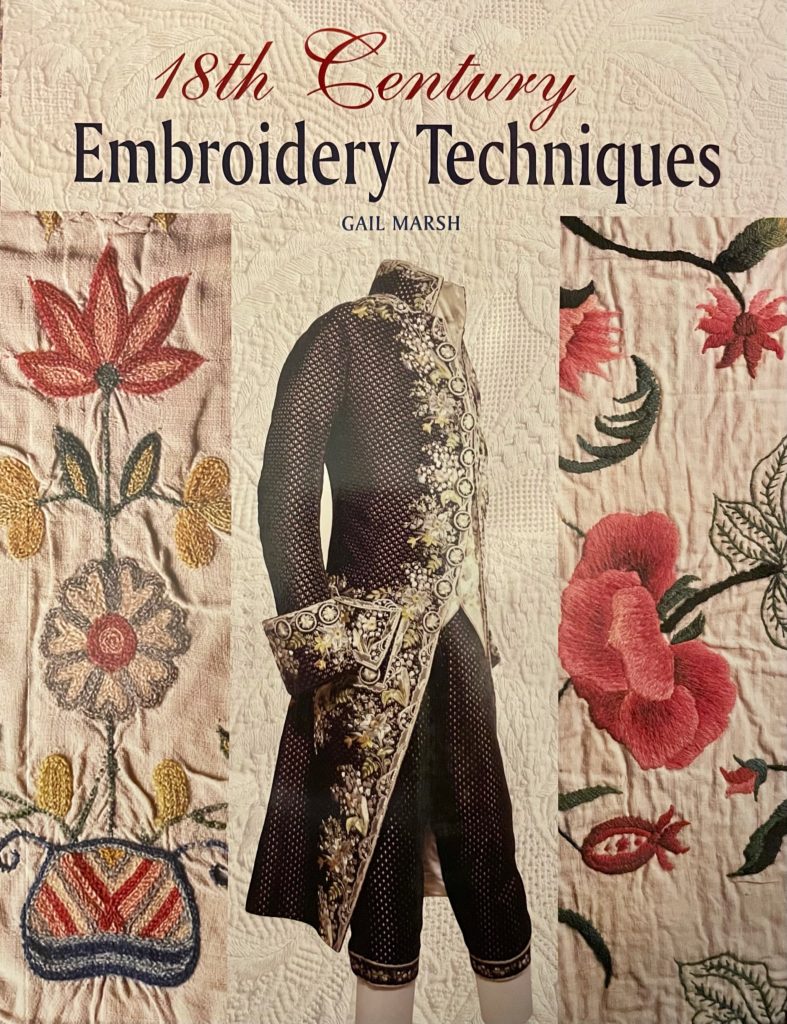Resource Review: 18th Century Embroidery Techniques by Gail Marsh

I ordered this book earlier in 2020 after taking an embroidery workshop as part of the Beginner’s Guide to the 18th Century Virtual Workshop Weekend. I ordered my copy from Wm. Booth, Draper, but it is also available on Amazon.
18th Century Embroidery Techniques is based on Marsh’s Master of Arts thesis, and includes an introduction, two large subdivided sections, two appendices, a glossary, and bibliography. The book contains color photographs of many of the garments and items discussed, along with line drawings showing the details of embroidered sections.
After briefly explaining in the Introduction how and why she wrote the book, Marsh moves into the first large section of the book – “The 18th-Century Embroiderer”. Rather than just including a list of tools and equipment, she takes the time to discuss each at length, and shows photos or line drawings of many of them. In addition to explaining how some tools were made (such as needles), she includes quotes from a variety of written sources from the period that mention these tools. The section discussing the working life of professional embroiderers was especially interesting to me. Most of my experience with embroidery is in the form of modern crafters, some of whom do all aspects of their embroidery projects from drawing the design to stitching it. This subsection also includes a detailed description of how an embroidered garment would be created, from laying out the embroidery pattern and stitching the motifs to sewing up the garment, and who was involved at each of these stages. Not everything was done by the same person. Marsh separates the discussion of work done by professional embroiderers from those doing embroidery in the home, but also points out that decorative elements for garments could be made in the home as well as in a shop.
The second, much larger, section of the book is “Embroidery Techniques”, which is subdivided into sections that discuss techniques using metal thread and spangles, silk embroidery, quilting, whitework, tambour and chain embroidery, crewel work, and novelty threads. Not only does Marsh discuss how each of these techniques was done, she includes passages from period documents discussing the technique. Photographs and line drawings supplement the written descriptions. Each technique section includes the discussion of garments and textiles she studied. These descriptions include line drawings and commentary that explain how specific motifs in the garment or item were worked.
There are two appendices included in the book, one on “The Availability of Clothes” that briefly discusses what fabrics and fashions were available when and to whom (and why that was the case), and a second on “Museum Study Advice”, which provides information on what to document when studying extant garments. If you are going to go study extant textiles and garments, be sure to check what the institution’s specific rules are for handling and documenting items in their collections.
Overall, the tone of the book bridges the academic and popular style of writing very well, and provides a good overview of the techniques used during the 18th century. In many cases, the illustrations convey more information than the photographs can. By providing the stitches used to create some of the motifs discussed in the book, it would be possible to recreate some of them yourself. The inclusion of a glossary helps the text flow well – it’s not interrupted by definitions of terms in the middle of a motif discussion. The bibliography also provides plenty of other resources on specific aspects of embroidery in the 18th century. However, the focus of the book on examples from the UK makes me leery of copying them exactly without confirming that similar examples existed in North America at the time.